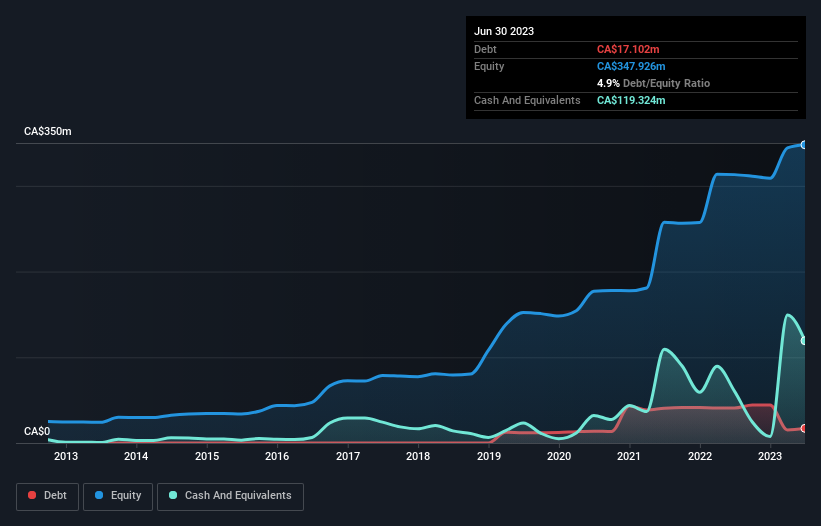- Canada
- /
- Metals and Mining
- /
- TSXV:AOT.H
Ascot Resources (TSE:AOT) Has Debt But No Earnings; Should You Worry?
Legendary fund manager Li Lu (who Charlie Munger backed) once said, 'The biggest investment risk is not the volatility of prices, but whether you will suffer a permanent loss of capital.' It's only natural to consider a company's balance sheet when you examine how risky it is, since debt is often involved when a business collapses. We note that Ascot Resources Ltd. (TSE:AOT) does have debt on its balance sheet. But is this debt a concern to shareholders?
Why Does Debt Bring Risk?
Debt and other liabilities become risky for a business when it cannot easily fulfill those obligations, either with free cash flow or by raising capital at an attractive price. In the worst case scenario, a company can go bankrupt if it cannot pay its creditors. However, a more usual (but still expensive) situation is where a company must dilute shareholders at a cheap share price simply to get debt under control. Of course, debt can be an important tool in businesses, particularly capital heavy businesses. When we think about a company's use of debt, we first look at cash and debt together.
View our latest analysis for Ascot Resources
How Much Debt Does Ascot Resources Carry?
As you can see below, Ascot Resources had CA$17.1m of debt at June 2023, down from CA$40.9m a year prior. However, it does have CA$119.3m in cash offsetting this, leading to net cash of CA$102.2m.

How Strong Is Ascot Resources' Balance Sheet?
We can see from the most recent balance sheet that Ascot Resources had liabilities of CA$22.6m falling due within a year, and liabilities of CA$222.0m due beyond that. Offsetting these obligations, it had cash of CA$119.3m as well as receivables valued at CA$1.56m due within 12 months. So it has liabilities totalling CA$123.7m more than its cash and near-term receivables, combined.
While this might seem like a lot, it is not so bad since Ascot Resources has a market capitalization of CA$227.9m, and so it could probably strengthen its balance sheet by raising capital if it needed to. However, it is still worthwhile taking a close look at its ability to pay off debt. Despite its noteworthy liabilities, Ascot Resources boasts net cash, so it's fair to say it does not have a heavy debt load! There's no doubt that we learn most about debt from the balance sheet. But ultimately the future profitability of the business will decide if Ascot Resources can strengthen its balance sheet over time. So if you're focused on the future you can check out this free report showing analyst profit forecasts.
Since Ascot Resources has no significant operating revenue, shareholders probably hope it will develop a valuable new mine before too long.
So How Risky Is Ascot Resources?
Statistically speaking companies that lose money are riskier than those that make money. And the fact is that over the last twelve months Ascot Resources lost money at the earnings before interest and tax (EBIT) line. And over the same period it saw negative free cash outflow of CA$104m and booked a CA$19m accounting loss. With only CA$102.2m on the balance sheet, it would appear that its going to need to raise capital again soon. Summing up, we're a little skeptical of this one, as it seems fairly risky in the absence of free cashflow. The balance sheet is clearly the area to focus on when you are analysing debt. However, not all investment risk resides within the balance sheet - far from it. To that end, you should learn about the 2 warning signs we've spotted with Ascot Resources (including 1 which is a bit concerning) .
Of course, if you're the type of investor who prefers buying stocks without the burden of debt, then don't hesitate to discover our exclusive list of net cash growth stocks, today.
New: Manage All Your Stock Portfolios in One Place
We've created the ultimate portfolio companion for stock investors, and it's free.
• Connect an unlimited number of Portfolios and see your total in one currency
• Be alerted to new Warning Signs or Risks via email or mobile
• Track the Fair Value of your stocks
Have feedback on this article? Concerned about the content? Get in touch with us directly. Alternatively, email editorial-team (at) simplywallst.com.
This article by Simply Wall St is general in nature. We provide commentary based on historical data and analyst forecasts only using an unbiased methodology and our articles are not intended to be financial advice. It does not constitute a recommendation to buy or sell any stock, and does not take account of your objectives, or your financial situation. We aim to bring you long-term focused analysis driven by fundamental data. Note that our analysis may not factor in the latest price-sensitive company announcements or qualitative material. Simply Wall St has no position in any stocks mentioned.
About TSXV:AOT.H
Ascot Resources
Engages in the exploration, evaluation, and development of mineral properties in the United States and Canada.
Moderate risk with imperfect balance sheet.
Market Insights
Weekly Picks


Crazy Undervalued 42 Baggers Silver Play (Active & Running Mine)


Fiducian: Compliance Clouds or Value Opportunity?

Willamette Valley Vineyards (WVVI): Not-So-Great Value
Recently Updated Narratives

Watch Pulse Seismic Outperform with 13.6% Revenue Growth in the Coming Years

Significantly undervalued gold explorer in Timmins, finally getting traction

Moderation and Stabilisation: HOLD: Fair Price based on a 4-year Cycle is $12.08
Popular Narratives


MicroVision will explode future revenue by 380.37% with a vision towards success


NVDA: Expanding AI Demand Will Drive Major Data Center Investments Through 2026





